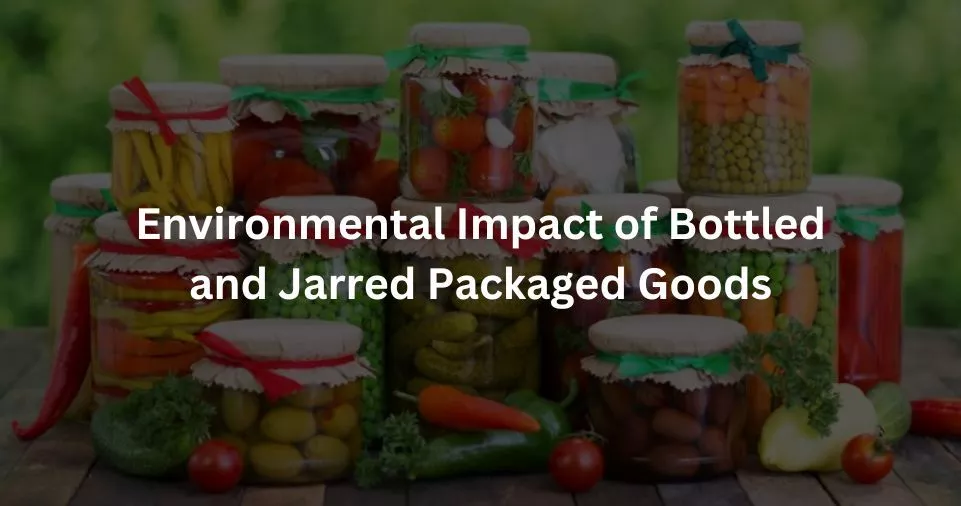Bottled and jarred packaged goods-Things you need to know about them!
Are you struggling with understanding the nuances of bottled and jarred packaged goods? You’re not alone in this – it’s a common issue, faced by many consumers and businesses alike. We’ve all been in situations where we’ve questioned the quality, safety, and sustainability of these products, without really knowing the answers. However, fear not, as this blog post promises to shed light on the intricacies of bottled and jarred packaged goods, and provide tangible solutions to help you make informed choices.
By offering an overview of the factors involved – from the manufacturing process to health and environmental impacts – we assure you that we’ll tackle your questions head-on. More importantly, by addressing these concerns directly, we’ll help you grasp the realities and repercussions associated with bottled and jarred packaged goods.
Now, imagine a scenario where you could browse the supermarket aisles, confidently picking out the best quality, sustainably packaged goods, knowing that you’ve made a responsible choice. This could be you after reading our comprehensive guide on bottled and jarred packaged goods.
Understanding Bottled and Jarred Packaged Goods
A Brief History and The Rise of Bottled and Jarred Packaged Goods
When it comes to the world of food preservation, bottled and jarred packaged goods have revolutionized the way we store and consume our foods. Their history is intertwined with humanity’s pursuit of convenience and longevity, stretching back to the 19th century. During this time, Napoleon Bonaparte offered a cash prize to anyone who could devise a way to preserve food for his armies. The answer came in the form of glass bottling, paving the way for what we know today.
In the modern era, bottled and jarred packaged goods have seen exponential growth. Their convenience, long shelf life, and extensive range make them a common sight in households worldwide. Who doesn’t appreciate the ease of having ready-to-eat pasta sauce or the tangy relish of pickles available at their fingertips?
The Manufacturing Process: An Inside Look
Moving on to how these bottled and jarred packaged goods are produced, the process is meticulous. It starts with quality raw materials. Next, these ingredients undergo processes such as cleaning, peeling, slicing, or blanching depending on the specific product.
The contents are then placed into jars or bottles. These containers undergo a heat treatment process known as sterilization. This helps to kill any remaining bacteria, ensuring the food’s safety and prolonging its shelf life.
After cooling, the containers are labeled and prepared for distribution. It’s a fascinating journey, from farm to shelf, that makes our favorite goods readily accessible.
Health Implications of Bottled and Jarred Packaged Goods
Common Concerns Associated with These Products
Now, it’s essential to address the elephant in the room – are there health implications related to bottled and jarred packaged goods? In truth, there are concerns. Some individuals worry about the use of preservatives, while others are uneasy about potential chemical leaks from packaging.
It’s also crucial to note that not all bottled and jarred goods are created equal. The nutritional content can vary widely, with some items packed full of added sugars or salts.
Addressing Myths and Facts
However, not all concerns are founded on fact. For example, the myth about canned food being nutritionally inferior to fresh produce isn’t necessarily true. Nutrient loss occurs in all preservation methods, and in some cases, canned goods may even retain more nutrients due to the lack of exposure to air.
You may also like reading: Bagged Packaged Goods – Advantages, Types, and Benefits (Updated)
Tips for Identifying High-Quality Bottled and Jarred Packaged Goods
So, how can you ensure that your bottled and jarred packaged goods are of high quality? First, always check the ingredient list. Products with fewer, more recognizable ingredients tend to be better choices. Additionally, choose items that have lower levels of added sugars and sodium.
By taking these steps, you’ll feel more confident about your choices, knowing you’re getting the best from your bottled and jarred packaged goods. So, go forth and navigate those grocery aisles with your newfound knowledge and peace of mind.
Environmental Impact of Bottled and Jarred Packaged Goods

Sustainability Concerns: An Unignorable Reality
Turning to the environmental side, the footprint of bottled and jarred packaged goods is impossible to overlook. The materials used in packaging, especially plastic, pose considerable sustainability issues. The production process alone consumes a lot of energy and resources, contributing to greenhouse gas emissions.
Plus, the end of life for these products often sees them landfilled or littered, causing pollution and harm to wildlife. The convenience we enjoy can sometimes come with a heavy environmental price tag.
The Role of Recycling and Waste Management
Despite the challenges, recycling and proper waste management can mitigate some of these effects. Recycling reduces the need for raw material extraction and lowers energy usage. Meanwhile, responsible waste disposal prevents littering, preserving the integrity of our natural spaces.
However, remember that recycling is not the ultimate solution. Not all materials are recyclable, and even those that are, are often not recycled due to inconsistencies in waste management systems worldwide.
Real-World Examples of Sustainable Practices in the Industry
On a brighter note, some bottled and jarred packaged goods producers are stepping up their game. For example, brands are increasingly using recycled or biodegradable materials for packaging. Some even opt for refillable containers, providing a model of circular economy in action.
Making Informed Choices: A Practical Guide
Identifying Eco-Friendly and Safe Bottled and Jarred Packaged Goods
Now, how can you contribute positively? By choosing bottled and jarred packaged goods that are eco-friendly and safe. Look for products in recyclable packaging or those using a minimal amount of packaging. A little bit of reading and understanding labels can make a big difference.
Tips for Responsible Consumption and Disposal
Your role doesn’t end after the purchase. Consumption and disposal are equally important. Consume responsibly, avoid waste, and when you’re done, dispose of the packaging properly. If recycling is an option, do so. If not, dispose of the waste in a way that minimizes environmental harm
Case Studies: Brands Leading the Way in Sustainable Packaging
To inspire you, some brands are truly leading the charge in sustainable packaging. Companies like Ecologic, for example, use 100% recycled paper for their bottles. Others like Loop partner with major brands to provide reusable packaging, creating a return-and-refill model.
Navigating the world of bottled and jarred packaged goods doesn’t have to be a challenge. With the right knowledge, you can enjoy the convenience they offer without compromising your health or the health of our planet.
Conclusion
In navigating the intricate world of bottled and jarred packaged goods, it’s apparent that there’s more than meets the eye. These goods, while providing convenience and long shelf-life, are not devoid of considerations. From understanding their origins and manufacturing process, addressing health concerns, and debunking myths to acknowledging their environmental footprint and making informed choices, we’ve journeyed through it all.
Being informed consumers, we have the power to influence the industry. By making conscious choices, opting for eco-friendly packaging, and practicing responsible disposal, we can enjoy the benefits of these goods while minimizing their negative impacts. Remember, every choice counts in shaping a sustainable future for us and generations to come.
Frequently Asked Questions
1. Are bottled and jarred packaged goods unhealthy?
While some of these products may contain added sugars or salts, not all are unhealthy. It’s essential to read labels and choose products with minimal additives and preservatives.
2. Are there environmental concerns associated with bottled and jarred packaged goods?
Yes, the production, consumption, and disposal of these goods can contribute to environmental issues. However, responsible actions like choosing recyclable packaging, reducing waste, and recycling can help mitigate these effects.
3. How can I identify high-quality bottled and jarred packaged goods?
Look for products with fewer, recognizable ingredients. Also, opt for items with lower levels of added sugars and sodium.
4. Can I do anything to reduce the environmental impact of my consumption of these goods?
Absolutely! You can choose brands that use sustainable packaging, consume responsibly to reduce waste, and recycle wherever possible.
5. Are there companies focusing on sustainable practices in this industry?
Yes, several brands are working towards more sustainable packaging solutions, like using recycled materials or providing refillable containers.






